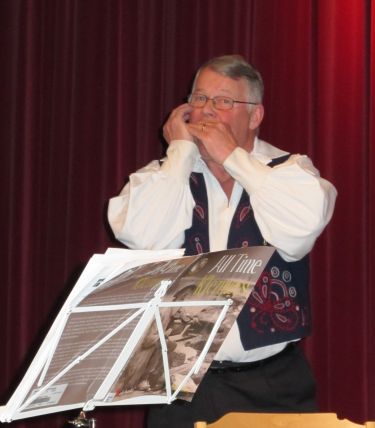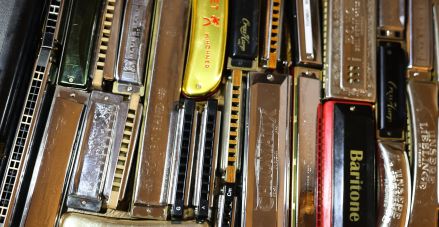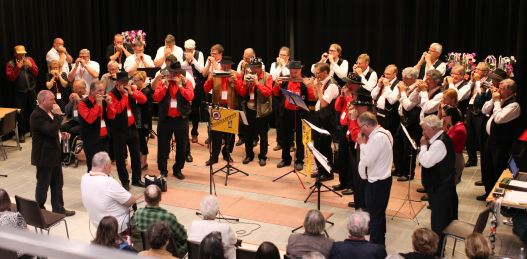Pelimanni-style harmonica playing
| Pelimanni-style harmonica playing | ||||
|---|---|---|---|---|
| In the national inventory | ||||
|

Practitioners and people who know the tradition well
Folk-style harmonica playing resembles accordion music. In the Finnish folk harmonica playing style, the musician simultaneously plays the melody and chord accompaniment, creating a clear rhythmic chord pattern beneath the melody, called self-accompaniment. This style of playing is rare worldwide, and the Finnish version is even considered unique. It gives the impression of two instruments being played simultaneously. Many bands also play in the folk style without bass and chord harmonicas. Orchestral playing on harmonica, with parts for chords and bass harmonica accompaniment, is less common. The tradition of playing the folk-style harmonica is diverse, with both active practitioners and occasional hobbyists participating. Additionally, this type of playing can be heard at various events. There is no precise information available on the number of folk-style harmonica players and public performances, but there have been surveys conducted to gather data on this. Statistics on the number of harmonicas sold in Finland are not available.
Various associations maintain and promote this tradition, and competitions and concerts play a significant role in preserving it. Approximately less than fifty harmonica players perform as soloists in the traditional style at harmonica playing competitions and concerts. Suomen huuliharpistit ry (The Finnish Harmonica Players Association), founded in Mäntyharju in 2004, currently has just over a hundred members. There are approximately ten communities in Finland where harmonica is played collectively. In addition to this, folk-style harmonica playing is also practiced for personal enjoyment at home. In collaboration with Suomen huuliharpistit ry, several registered or unregistered harmonica groups have been or are active. These groups can be found in various parts of Finland, including Pori (Horjumattomat), Vantaa (Huuliharppuyhtye Lipstikka), Vihti (Huuliveikot-Lipfellows and Duo Veikkolan Pojat), Mäntyharju (Mäntyharjun Huuliharpistit ry and Huulihärppes Quartet), Tampere (Pirkanmaan Huuliharpistit), Lahti (Päijät-Hämeen Huuliharpistit ry), Lappeenranta (Saimaan Harpistit ry), Helsinki (Sväng and Kaarlo Reinikainen's Huuliharppukvartetti from the 1950s), and Varkaus (Varkauden Huuliharpistit).

Festivals related to harmonica playing play a crucial role in practicing this tradition. The Liisan Höylät Festival in Laukaa was the first harmonica-focused festival held in Finland. It was initiated by folk music master Pentti Varkila, who led the festival for nearly two decades, starting from the late 1990s. In addition to Liisan Höylät, the Finnish Harmonica Players Association has organized the "MunnariTreffit" festival, which has been celebrated in Mäntyharju, Heinävesi, Lappeenranta, Outokumpu, Keuruu, Varkaus, and Hartola. When the festival was held in Orivesi in 2022, the name was changed to the "Finland Harmonica Festival." Other harmonica festivals include "Huuli & Harppu" in Ivalo, "Leksan kevätsoitto" in Levi, "Huuliajot" in Lappeenranta, and "Aminsoitot" in Outokumpu.
The preservation of the harmonica tradition is supported by the Finnish Folk Music Association, which organizes annual tests for folk musician badges. The bronze, silver, and gold folk musician badges require playing 20, 40, or 60 folk music pieces without sheet music. The Kaustinen Folk Music Festival board awards the title of "Mestaripelimanni" (Master Folk Musician) to accomplished harmonica players.
Practising of the tradition
The harmonica is played in the folk style at harmonica players' gatherings, competitions, concerts, celebrations, events, and at home. Competitions in Finland include the previously mentioned Finland Harmonica Festival, Etelä-Pohjalaiset Spelit, and Pelimannien Parhaat Kansansoittokilpailut in Alavus. At the Spelit, it is expected that only folk music in the folk style is performed as competition pieces. In other competitions, in the diatonic category, players can perform other music genres and playing styles.
Harmonica concerts are held in various parts of Finland every year. At the Spelit and the Kaustinen Folk Music Festival, harmonica players have the opportunity to perform their own playing presentation, a mini-concert lasting 20-30 minutes. Additionally, in Kaustinen, bands perform in their own concerts, and in the "Suuret Huuliharppukonsertit" (Great Harmonica Concerts) open to all players, folk music pieces are performed. In addition to larger events, the tradition of folk-style harmonica playing is also practiced on a smaller scale. Harmonica players, for example, perform individually or in groups at nursing homes, assisted living facilities, kindergartens, and at invited celebratory events.
The traditional folk style of harmonica playing has been passed down from generation to generation by ear, without a standardized, correct style. Each player has developed their own distinctive and recognizable way of playing. Learning by ear often involves the player trying to mimic or imitate a more experienced player, who may also serve as a teacher. The network of harmonica players has always been sparse in Finland, so players have often randomly adopted their playing style by imitating their teacher.
In addition to learning from others, most harmonica players have adopted their style through individual practice, without anyone teaching them. The anatomy of the mouth, individual tongue, lip, and oral cavity size and shape, breathing, lung capacity, tongue motor skills, playing technique, and skills determine the boundaries of playing. Therefore, the tone and chord accompaniment of each harmonica player are highly individual and different from one another. Harmonica manufacturers also produce various models with significantly different sounds. The choice of harmonica used for playing further adds to the diversity of harmonica players' styles.
The background and history of the tradition
The harmonica is believed to have arrived in Finland from Germany in the late 19th century. There are also indications that returning immigrants from North America brought harmonica music with them to Finland. There are no recorded details about playing or playing styles from those times, but information from the early 20th century suggests that self-respecting fiddlers did not even consider the harmonica as an instrument. The harmonica has been on the fringes as an instrument from its early days.
Presumably, playing the harmonica in the folk style began to spread with the growing popularity of pop music from the 1920s onwards. The harmonica is well-suited for playing rhythmic music because it can simultaneously play both melody and rhythm. The basis of the Finnish chord accompaniment and folk style is Finnish folk music, minor-key pop songs, and dance music. Jigs, polkas, waltzes, tangos all require a clear and rhythmic accompaniment. These genres have given rise to a unique rhythm and style that differs from, for example, Swedish hambo and major-key Central European music. During the wartime, corner dances were the golden age of the harmonica. The harmonica, being small in size and having a strong sound for rhythm, was well-suited for secretly accompanying hidden dances. It could also be easily concealed. Five hundred harmonicas were ordered from Germany and distributed to entertain the frontline soldiers during the long-lasting trench warfare. After the war, the tradition has been preserved thanks to a few folk-style harmonica players. In some places, there have been publicly performing folk-style harmonica players for a long time, but the tradition has been passed down from generation to generation, especially through home players. Due to its affordable price, the harmonica became the "everyman's instrument" after the war, and some players also learned the more demanding folk style.
Finnish harmonica playing is a valuable part of Finnish music culture. Chord accompaniment and the Finnish folk style have attracted interest and positive attention worldwide, as they differ from many other harmonica playing styles. For example, in the Far East, such as China, Malaysia, and Japan, harmonica players play with almost no chord accompaniment. In Europe as well, chord accompaniment and the rhythm of the playing vary by region, influenced, among other things, by local folk music.
The transmission of the tradition
The gatherings of harmonica players at competitions and concerts preserve and advance the tradition. For these events, songs are practiced and unique playing styles are presented and heard. These occasions offer the opportunity to learn from harmonica players who have reached a higher level of skill about how to play the harmonica. In recent years, there has been an effort to provide more structured training, even though there isn't a formal system for training new players. Training events have been organized sporadically in connection with harmonica festivals and by individual enthusiasts. Suomen Huuliharpistit ry as well as local bands and associations, have also organized training events. Mäntyharjun Huuliharpistit have developed a training method based on mutual interaction. In this method, playing skills are developed with the help of a peer group. The group performs a practiced song, which the listeners then assess. They provide feedback on the strengths of the performance and areas that need improvement.

On the other hand, the absence of standardized teaching for playing style is part of the tradition of folk-style harmonica playing. There is no single established technique or style of playing. Learning and playing by ear continue to be the foundation for preserving the tradition.
The future of the tradition
Traditional folk-style harmonica playing has clearly declined in recent years, reversing a period of about two decades of active engagement. The age distribution of players has reduced the number of harmonica players, and younger successors to the tradition have not joined in. The number of participants in harmonica competitions has dropped by an estimated half in the past two decades. Some competitions and categories have had to be canceled due to a lack of participants.
Reviving folk-style playing requires investment. There are young harmonica players, but their playing in ensembles is melodic, and rhythm is played on other instruments. Young people often choose blues as their style with the harmonica, or they play short interludes with the harmonica in rock-style bands. On the other hand, the chromatic harmonica is used to play jazz or classical music and evergreens.
However, there is no reason to doubt or fear the disappearance of folk-style playing. Harmonica playing with a chord accompaniment is a distinct area of harmonica playing for soloists. There is plenty of suitable music for folk-style players, and more is on the way. When there is a need and an audience for players, there will always be new dedicated folk-style harmonica players.
The significance of the tradition in society has varied over time. Before new technology from the mid-1970s onwards bypassed acoustic music, the harmonica was a very useful instrument for many situations. It brought comfort and joy to homes and small events. When electronically amplified instruments such as the guitar and electric organ became common, the popularity of the harmonica significantly declined. Harmonicas were left to gather dust on shelves and in closets. It is possible that, with the resurgence of folk music and other traditional styles, the harmonica may experience a small-scale renaissance. Young people have embraced folk music again, and the Sibelius Academy's folk music department also offers higher education in harmonica playing. However, folk-style playing is likely to continue being primarily a part of oral tradition and free from rigid rules.
The community/communities behind this submission
Eteläpohjalaiset Spelit Kansanmusiikkiyhdistys ry
Kaustisen Kansanmusiikki-instituutti
Huuliharppuyhteisöjen sivuille suomenhuuliharpistit.fi kautta
Bibliography and links to external sources of information
Videos
Kesän tullessa Juhani Niskanen 2017 Mäntyharju
PolkkapotpuriErkki Vihinen 2021 Jyväskylä
Suomen Joutsen Hannu Valkonen 2011 Mikkeli
Säkkijärven polkka Aimo Mantere 2011 Kaustinen
TV 1 Puoli seitsemän 21.2.2023 Elävä perintö kohdasta 5.45
Online sources
Juhani Niskanen: Pelimannityylisen huuliharpun soittotaidon kehittäminen vertaisryhmän tukea apuna käyttäen Osa I, (19.3.2021) suomenhuuliharpistit.fi
Pelimannityyli huuliharpulla, Pelimannityyli Unescon perinneluetteloon suomenhuuliharpistit.fi ( 25.3.2021)
Pelimannityyli huuliharpulla. Kansanmusiikki 2/2021 (26.5.2021)
Pelimannityylinen kielikomppi kansalliseen elävän perinnön luetteloon suomenhuuliharpistit.fi (30.4.2021)
Pelimannityylinen soitto huuliharpulla. Esitelmä Finland Harmonica Festivaaleilla Orivedellä 29.7.2022. suomenhuuliharpistit.fi
Ryhmädynamiikkaan perustuva opetusmetodi Osa II suomenhuuliharpistit.fi (17.5.2021)
Huuliharpun soiton terapeuttiset vaikutukset, 2013. Kyselytutkimuksen aineisto ja tulosten yhteenveto Kaustisen Kansanmusiikki-instituutin arkistossa. Tutkimuksen kysymykset ja tutkimussuunnitelma, suomenhuuliharpistit.fi
Bibliography
Anne-Mari Hakamäki, Pelimanniuden määritelmät kansanmusiikin harrastajien ja ammattilaisten keskuudessa 2010-luvulla. Pro gradu 2017, Sibelius-Akatemia
Jouko Kyhälä-Jimmy Träskelin:Pelti polskia laulaa Kansanmusiikkia blueshuuliharpulla. Kansanmusiikki-instituutti, 2009 Tietokirja ja soitto-opas
Komulainen Jari & Ojajärvi Janne: Turpahöylän ensitahdit. Huuliharpun alkeet ja ohjelmistoa.
Timmy Träskelin: Pelti polskia laulaa: Huuliharppupedagogiikkaa sanoina ja kuvina, 2011 Opinnäytetyö
Other sources
Kielibasso (CD-levy), toimittanut Jimmy Träskelin
Suomen Huuliharpistit ry:n sivuilla ja blogissa (suomenhuuliharpistit.fi) on runsaasti kuvia, klippejä ja kirjoituksia huuliharpusta, huuliharpun soitosta, pelimannityylisestä kielikompista, huuliharppu tapahtumista ja yhteisöistä.
